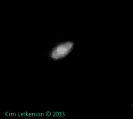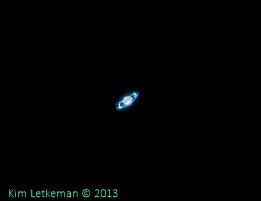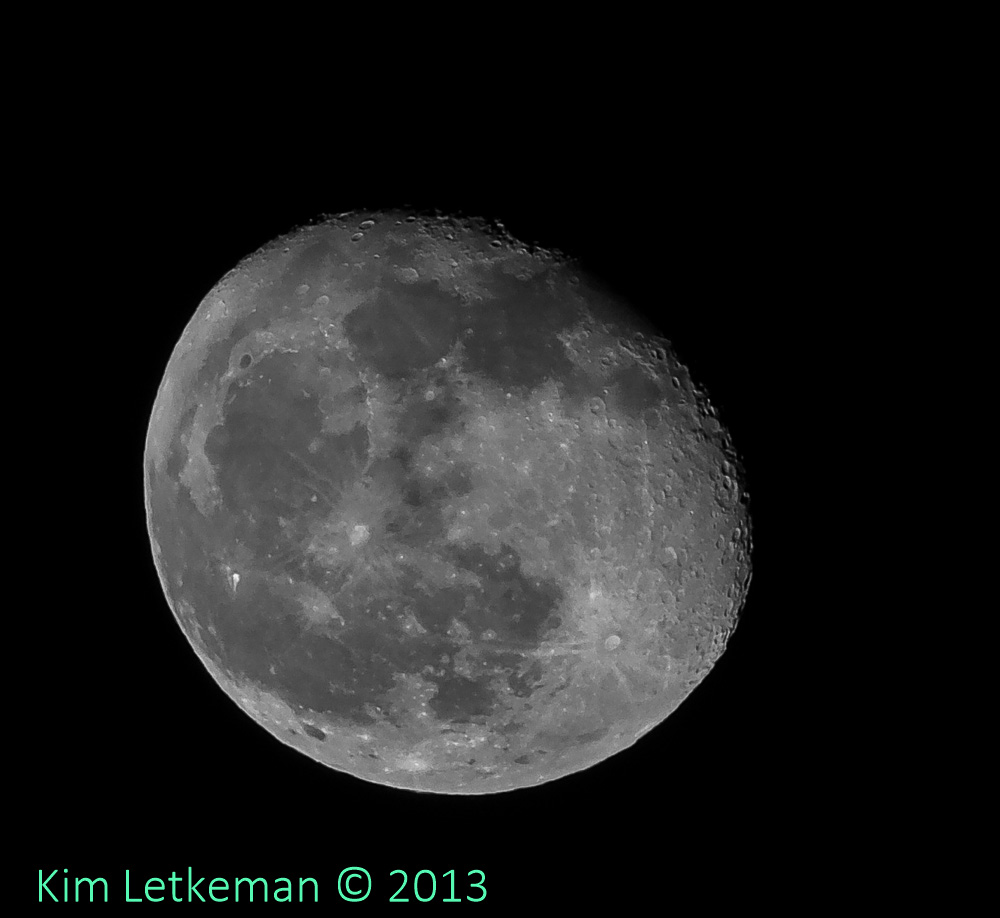And again the HS50 takes center stage. The evening started with clearing skies tonight and by the time the Moon and Saturn rose in the southeastern sky, the skies were crystal clear. When one has the opportunity to shoot a camera with a true telescope focal range (there are more than a few legitimate telescopes whose focal lengths fall short of the HS50’s massive 1000mm) what should one do? Why, shoot for the moon of course … and Saturn since it was hanging out in the vicinity.
So … the moon first. I tested M size first and found it to shoot very clean images. (Well, duh.) And although it’s only 8mp, the 1000mm makes up for a lot of sins :-)

HS50EXR @185mm (1000mm EFL) 100iso f/8 1/80
Following the “sunny 16” rule, I think this should have been an over exposure, but it was actually really nice. The edges of the moon were perfect, with none of the weird artifacts or CA I’ve seen in the past. Big kudos to Fuji on the quality of the lens at full zoom. I shot a lot of images and found a very small percentage of them to be slightly blurry, indicating that the “seeing” was very good tonight. Great air, in other words.
Other interesting settings:
Normal sharpness because high creates nasty artifacts. DR100 because it does not need to be higher (the moon has no dynamic range to speak of.) NR turned down low. The perfect settings for this task.
Here’s a second take on the same file. For the first one, I used OnOne’s Perfect Effects Free Edition and got some nice contrast in there. For this one, it is all Lightroom.
That one is a bit more subtle in every way. But still nicely detailed and smooth where the moon should be smooth.
Now we switch to an L sized file. I was pretty surprised when I started looking at the L files at the amount of noise in some of them. I was experimenting with settings and found that this file had some of the sharpest rendering of craters. But it also had much more noise than the M sized file (which is a given, of course.) The settings here are the same as for the M sized file by the way.
The place where L size fails is in areas of low contrast detail, and the place where I notice it the most is the little lines coming out of the craters. They just do not have good edge definition, as there is a lot of noise and smearing caused edge destruction. Very nice craters, though … I gotta say.

HS50EXR @185mm (1000mm EFL) 100iso f/8 1/80
Ok … some very nice moon detail and pretty clean open spaces. I prefer the L sized craters and the M sized everything else. Exactly what I always say … M size generally provides a nice file because so much of the detail that matters is fine, low contrast detail.
And we move on to Saturn. I played around with various settings and ended up getting several decent renderings of Saturn. I’ll just post a few of them here with their settings … there is not much to discuss since I have posted many times before. Saturn is a tough object to shoot in that you need perfect support and a perfect exposure to be able to separate the rings from the planet.
Well, with this level of magnification, separating the rings is a given. So here we go … Here is a wee one to start …. note the excellent separation of the rings.

HS50EXR 100iso f/8 1/80
Yes, it’s pretty small. And note that I accidentally left the moon settings on. The rest of the settings (tone, sharpness, NR) were all on the lowest setting. I think it turned out pretty decently when you consider that I exposed for sunlight and shot a planet many millions of miles away.

HS50EXR 3200iso f/8 1/50
A bigger and cleaner image. I had to reduce exposure quite a bit, but lots of detail emerged. The rung separation is very clear, and that is a bit of a thrill. Settings all remain at low. It’s a tad larger, and yes, I shot this one at L size (M size for the first one.) L size here can do no damage since there is no large low contrast detail surface to be smoothed.
And the same file processed in Perfect Effects … with rather a lot of effects stacked up.

That’s a bit much, but it shows the saparation of the rings really well. A bit distorted, but it is unmistakable.
And there you have it. A fun and successful half hour of planetary exploration. The focal range on this thing is just breathtaking. But it is the acuity of the lens at full zoom that is mesmerizing.

